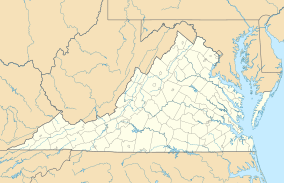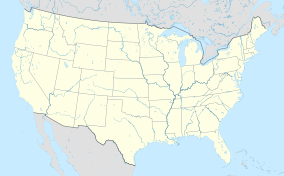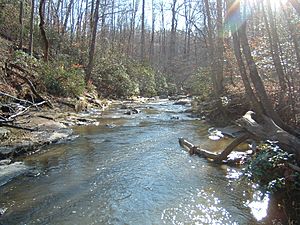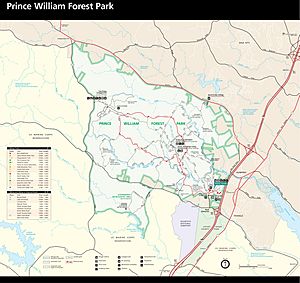Prince William Forest Park facts for kids
Quick facts for kids Prince William Forest Park |
|
|---|---|
|
IUCN Category III (Natural Monument)
|
|
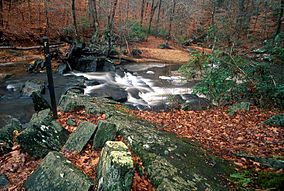
Quantico Creek in Prince William Forest Park
|
|
| Location | Triangle, Virginia, United States |
| Nearest city | Dumfries, Virginia |
| Area | 16,084 acres (65.09 km2) |
| Established | November 14, 1936 |
| Visitors | 379,535 (in 2011) |
| Governing body | National Park Service |
| Website | Prince William Forest Park |
Prince William Forest Park is a huge natural area in Triangle, Virginia. It was created in 1936 and was first called Chopawamsic Recreational Demonstration Area. This park is right next to Marine Corps Base Quantico. It's the biggest protected natural space in the Washington, D.C. area, covering over 16,000 acres (6,500 ha) (that's about 25 square miles!).
Today, the park shows us what much of the East Coast looked like hundreds of years ago. It's a great example of an Eastern Piedmont forest, which is a type of forest found in the hilly areas between mountains and the coast. The park also protects the Quantico Creek watershed, which means it helps keep the water clean for the creek and the animals that live there. It's a safe home for many different plants and animals.
Park History: From Towns to Trails
Prince William Forest Park has a long and interesting past. Before it became a park, there were small towns here, like Batestown. This community was a special place for freed slaves, named after Mary Bates, an important woman in the area.
In the 1930s, during a tough time called the Great Depression, the government started a program. It was called the Resettlement Administration. The idea was to help farmers move to better land. So, the government bought many properties in areas like Hickory Ridge and Batestown. They wanted to create a new recreation area called Chopawamsic Recreational Demonstration Area.
However, many people who lived there didn't want to leave their homes. Some even tried to hide within the park's boundaries to avoid being found. This continued until World War II began. During the war, the park was taken over by the Office of Strategic Services (OSS). This was a secret group that trained spies and radio operators! The park was surrounded by barbed wire and guards. Sadly, all the remaining families were forced to leave their homes.
After the war ended, these families hoped they could get their land back. But instead, the land was given to the National Park Service and renamed Prince William Forest Park. The families never received payment for their lost homes.
Many of the park's buildings, roads, and lakes were built between 1936 and 1942. This work was done by people from the Civilian Conservation Corps (CCC) and the Works Progress Administration (WPA). These were government programs that helped people find jobs during the Great Depression.
Today, you can still find signs of the past. The park has historic areas listed on the National Register of Historic Places. These include the sites of the old communities and the Cabin Branch Pyrite Mine Historic District.
Fun Things to Do in the Park
Prince William Forest Park offers many exciting ways to explore nature and history.
- Spotting Wildlife: You can often see different animals in their natural home.
- Hiking Adventures: There are 37 miles (60 km) of hiking trails. Many of these trails lead to historical spots or follow Quantico Creek, where you can see small waterfalls.
- Biking Paths: Enjoy 21 miles (34 km) of roads and trails perfect for bicycles.
- Camping Under the Stars: The park has different camping options. You can set up a tent with your family or a group. There are also rustic cabins and a full-service RV campground.
Amazing Animals of the Park
Prince William Forest Park is home to a wide variety of animals. Keep your eyes open, and you might spot some of these creatures!
- Reptiles: Look for Eastern box turtles, especially after it rains. You might also see different kinds of skinks sunning themselves on the trails. Eastern black rat snakes can be found near logs and bushy areas.
- Amphibians: The park has many amphibians, which are animals that live both on land and in water. You might hear or see toads and frogs like the American toad, American bullfrogs, and Cope's gray tree frog. Salamanders, such as the marbled salamander and the eastern red-backed salamander, also live here.
- Birds: Many bird species call the park home. These include the colorful hooded warbler, the singing wood thrush, and the majestic red-shouldered hawk.
- Mammals: You might spot mammals like red foxes, beavers, and white-tailed deer. Sometimes, even black bears and coyotes are seen, especially along the upper North Valley Trail.


